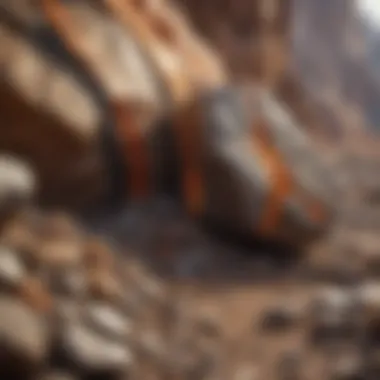Understanding Rocks and Minerals: In-depth Analysis


Intro
Rocks and minerals compose the very foundation of our planet. Understanding these elements provides insight not only into the Earth's history but also into the processes that shape our environment. This exploration will engage rock and fossil collectors, educators, and enthusiasts by unraveling the complexities of both rocks and minerals.
History and Origins
Overview of Collectibles, Rocks, and Fossils
Collecting rocks and fossils is an ancient practice. It dates back to early civilizations that marveled at the natural formations around them. From the moment humans first noticed the diverse textures and colors of stones, these materials captured attention and stimulated curiosity. Collectors often seek unique specimens, driven by an appreciation for geology and the stories that rocks tell about our planet's past.
Historical Significance and Cultural Impact
Throughout history, rocks and minerals have held significant cultural value. Many societies have attributed spiritual meanings to specific stones, seeing them as conduits for healing or protection. For example, jade is highly revered in Chinese culture, symbolizing purity and moral integrity. Similarly, quartz crystals are often linked to clarity and focus in various belief systems. Thus, the historical importance of these materials extends beyond their physical presence.
Identification and Classification
Guide to Identifying Rocks and Fossils
Identifying rocks and fossils requires keen observation and an understanding of their characteristics. The first step is to categorize the specimen into one of three major types:
- Igneous: Formed from cooled magma or lava. Examples include granite and basalt.
- Sedimentary: Created from the accumulation of minerals and organic matter, such as limestone or sandstone.
- Metamorphic: Resulting from the transformation of existing rock types under heat and pressure, like marble and schist.
To successfully identify a specimen, collectors should consider factors such as color, texture, hardness, and the presence of any distinct features or fossils.
Common Types and Variations
Diversity is a hallmark of rocks and minerals. Each type carries its own variations, with notable examples including:
- Granite: A coarse-grained igneous rock prized for its beauty and utility in construction.
- Shale: A fine-grained sedimentary rock known for its ability to preserve fossils.
- Schist: A metamorphic rock distinguished by its foliation and shiny appearance.
Rocks and minerals not only tell a story of the Earth's formation but also play crucial roles in various industries, from construction to technology.
By grasping the distinctions and classifications of rocks and minerals, collectors can gain a deeper appreciation for their collection and the vast narratives that each specimen embodies.
Prolusion to Rocks and Minerals
Rocks and minerals form the backbone of our planet's geological structure. Understanding these elements goes beyond academic curiosity; they play crucial roles in various fields such as construction, economic exploration, and even environmental preservation. This article aims to provide an intricate examination of rocks and minerals, dissecting their definitions, classifications, and formations, along with their practical significance. By delving into these themes, the reader will not only grasp foundational concepts but also appreciate the broader implications of these natural materials.
Defining Rocks
Rocks are solid aggregates composed of one or more minerals, mineraloids, or organic materials. They are classified into three main categories: igneous, sedimentary, and metamorphic. Each type reflects different methods of formation and mineral composition.
- Igneous rocks result from the cooling and solidification of molten material called magma. When magma erupts and cools quickly on the Earth's surface, these rocks are termed extrusive. An example includes basalt. Alternatively, intrusive rocks like granite form when magma cools slowly beneath the surface.
- Sedimentary rocks originate from the accumulation and compaction of mineral and organic particles. They often exhibit layered structures, and examples include sandstone and limestone.
- Metamorphic rocks, on the other hand, arise from pre-existing rocks undergoing transformations under heat and pressure. Marble and schist are common examples in this category.
Defining Minerals
Minerals are naturally occurring, inorganic solids with a definite chemical composition and an ordered internal structure. Their properties vary significantly depending on their composition and crystal structure. To be classified as a mineral, a substance typically meets five criteria:
- It must be naturally occurring.
- It should be solid at room temperature.
- It must have a specific geometrical structure.
- It must have a defined chemical composition.
- It should be inorganic, meaning it cannot be formed from living organisms.
Minerals can be broadly classified into two categories: silicate and non-silicate minerals. Silicate minerals, such as quartz and feldspar, contain silicon and oxygen, forming about 90% of the Earth's crust. Non-silicate minerals, including calcite and halite, lack this silicon-oxygen framework but play vital roles in various geological and environmental processes. Understanding minerals and their specific characteristics provide a solid foundation for exploring more intricate geological phenomena.
The Composition of Rocks and Minerals
Understanding the composition of rocks and minerals is fundamental in the study of geology. This section elucidates the core components that define rocks and minerals, shedding light on their properties and behaviors. By grasping the intricate dance of elements and compounds, one can appreciate the unique characteristics that distinguish each mineral and rock type.
Elements and Compounds in Minerals
Minerals are primarily composed of elements. The most common elements found in minerals include oxygen, silicon, aluminum, iron, calcium, sodium, potassium, and magnesium. These elements combine in various ways to form specific compounds, which in turn shape mineral properties.
- Silicates: This is the most prevalent group of minerals, characterized by silicon and oxygen. For example, quartz is a silicate mineral composed of silicon dioxide (SiO2). The tetrahedral structure of silicates leads to a wide variety of forms and intricate structures.
- Carbonates: Comprising minerals like calcite and dolomite, carbonates are based on the carbonate ion (CO3) combined with various metals. These minerals are essential in sedimentary rock formation.
- Oxides and Sulfides: Oxides, such as hematite and magnetite, consist of oxygen combined with metals. Sulfides contain sulfur combined with metals, exemplified by pyrite and galena.
These elements and compounds form the backbone of mineral classification and are crucial for both practical applications and academic study.
Mineral Crystallography
Mineral crystallography is crucial for understanding the symmetries and structures of minerals. It examines how atoms are arranged within a mineral and how this organization affects its properties. Many minerals crystallize in defined patterns, which can be classified into distinct crystal systems. These include:


- Cubic: Minerals like halite and pyrite exhibit cubic symmetry in their crystal formation.
- Tetragonal: This system includes minerals like zircon, with a square base and equal axis lengths.
- Hexagonal: Crystals like quartz can be categorized in this system and often display a six-sided symmetry.
The study of crystallography enhances our understanding of mineral identification. It helps in discerning minerals under a microscope based on their distinctive crystal habits and shapes.
"The arrangement of atoms in a mineral not only determines its physical appearance but also its optical properties and reactivity."
Geological Processes Involved in Rock and Mineral Formation
Understanding the geological processes that lead to the formation of rocks and minerals is essential for grasping their characteristics and the environments in which they are found. These processes not only shape the natural world but also influence economic ventures and ecological balance. In this section, we will explore three primary types of rock formation: igneous, sedimentary, and metamorphic. Each of these processes contributes to the diversity of geological formations and offers insights into Earth's history and evolution.
Igneous Rock Formation
Igneous rocks originate from the solidification of molten material known as magma, which is found beneath the Earth’s crust. The process of igneous rock formation varies based on where the magma cools and solidifies. If it cools below the surface, intrusive igneous rocks, such as granite, are formed. Conversely, if the magma erupts and cools on the surface, it creates extrusive igneous rocks like basalt.
Key considerations include:
- Cooling Rate: The speed at which magma cools impacts the size of the crystals formed. Slow cooling allows for larger crystals.
- Mineral Composition: The minerals present in the magma determine the type of igneous rock produced. For example, a higher silica content leads to lighter-colored rocks.
- Volcanic Activity: Active volcanic regions often have a higher concentration of extrusive igneous rocks, which can be of significant interest to collectors.
This process is not only fascinating; it unlocks information about Earth's mantle and the tectonic activities that reshape our planet.
Sedimentary Rock Formation
Sedimentary rocks form through the accumulation and compaction of sediments over time. These sediments can be remnants of pre-existing rocks, organic materials, or minerals precipitated from solution. The formation of sedimentary rocks involves several stages: weathering, erosion, transportation, deposition, and lithification.
Factors to consider include:
- Origin of Sediments: Clastic sediments are derived from other rocks, while chemical sediments come from dissolved minerals in water.
- Stratification: This process leads to the layering of sediments, often observable in a cross-section. Such layers can reveal historical changes in environments.
- Fossils: Sedimentary rocks often contain fossils, providing valuable information on past life forms and environmental conditions.
Understanding sedimentary processes is vital for geologists and collectors, as it provides insight into Earth’s history and can indicate the presence of natural resources, such as coal or oil.
Metamorphic Rock Formation
Metamorphic rocks are formed from existing rocks—igneous, sedimentary, or other metamorphic rocks—under intense heat, pressure, or both. The fundamental change they undergo is called metamorphism, leading to alterations in mineral composition and texture.
Considerations are:
- Parent Rocks: The original rocks, or parent rocks, function as the foundation from which metamorphic rocks originate.
- Foliation: Many metamorphic rocks exhibit a layered appearance due to the alignment of minerals under pressure. This characteristic is key in identifying specific types of metamorphic rocks, such as schist or gneiss.
- Temperature and Pressure: The specific conditions during metamorphism determine the extent of change. Higher temperatures can lead to more profound transformations.
Metamorphic processes illustrate the dynamic nature of Earth and allow collectors to find unique specimens. It is important to note that understanding these rocks assists in evaluating potential mining opportunities as well.
"Geological processes are the foundation of understanding not only the materials at hand but also the history of our planet."
Classification of Minerals
The classification of minerals plays a pivotal role in our understanding of geology and mineralogy. A well-defined framework helps in identifying minerals accurately. This process is essential not only for academic purposes but also for practical applications in various fields. By classifying minerals, one gains insights into their properties, origins, and potential uses. Moreover, this information can guide collectors in identifying and valuing their specimens effectively.
Silicate vs. Non-Silicate Minerals
Minerals can broadly be divided into two categories: silicate and non-silicate minerals. Silicate minerals are the most abundant group on Earth, making up about 90% of the Earth's crust. These minerals are characterized by the presence of silicon and oxygen in their chemical structure, typically forming the silicate tetrahedron, which is a pyramid-shaped arrangement where four oxygen atoms surround one silicon atom. Common examples include quartz, feldspar, and mica.
On the other hand, non-silicate minerals encompass a diverse range of mineral types that do not contain silicon-oxygen frameworks. They include important groups such as carbonates, oxides, and sulfates. For instance, calcite, which is a carbonate mineral, is fundamental in the formation of limestone and plays a crucial role in various biological and geological processes.
Both classes of minerals have distinct physical and chemical properties that affect their behavior in geological environments. Understanding these differences is vital for mineral collectors and enthusiasts, as it allows for a more informed selection and appreciation of their specimens.
Identification of Minerals
Identifying minerals is a systematic process that employs various techniques. Key characteristics to consider include color, hardness, luster, streak, cleavage, and fracture.
- Color: While it can be misleading, color provides an initial clue about the identity of a mineral. However, many minerals can occur in various colors due to impurities.
- Hardness: The Mohs scale of hardness ranks minerals from 1 (talc) to 10 (diamond). This scale is a practical tool for determining the scratch resistance of a mineral.
- Luster: This describes how a mineral reflects light. Luster can be metallic, glassy, dull, or even resinous, among other appearances.
- Streak: The streak test involves rubbing a mineral against a porcelain plate to reveal its color in powdered form, which may differ from its external color.
- Cleavage and Fracture: Cleavage refers to the tendency of a mineral to break along specific planes. In contrast, fracture describes how a mineral breaks in an irregular manner.
Utilizing these methods can enhance the accuracy of mineral identification. For collectors, accurately identifying minerals greatly enhances their collection's value and educational content.
"Understanding the classification and identification of minerals not only enriches the knowledge of geologists but also empowers collectors to appreciate their specimens fundamentally."
By focusing on the classification of minerals, one gains a deeper appreciation of their complexity and significance in both natural and human contexts.
Rocks: Physical and Chemical Properties


Understanding rocks involves examining their physical and chemical properties. These attributes are crucial as they determine how rocks behave under various conditions. This section elaborates on textural characteristics and chemical composition and reactions, which highlight the differences among various rock types and their uses in human activities.
Textural Characteristics
The texture of a rock refers to the size, shape, and arrangement of the mineral grains within it. Rock texture significantly affects the rock's strength and durability. For example, granite has a coarse texture with large grains, making it suitable for construction. Conversely, basalt has a fine texture, which also has its unique applications.
Key textural characteristics to consider include:
- Grain size: Influences how light interacts with the rock, affecting its color and overall appearance.
- Grain shape: Rounded grains may indicate transportation by water, while angular grains suggest recent fractures.
- Grain arrangement: Whether the grains are interlocking or loose can affect the rock's strength and porosity.
Understanding these factors helps collectors evaluate rocks for their aesthetic values and practical applications. Recognizing the textural characteristics of rocks also aids in geological identification and analysis.
Chemical Composition and Reactions
The chemical composition of a rock dictates its mineral content and overall classification. Rocks are composed of different minerals, each defined by specific chemical formulas. For instance, quartz is primarily silicon dioxide (SiO₂), while feldspar is a mix of aluminum silicates.
Additionally, the chemical reactions occurring in rocks can lead to important transformations. Some key points include:
- Weathering and Erosion: Chemical weathering alters the minerals within a rock through reactions with water, air, or acids, gradually breaking them down.
- Metamorphism: Under high pressure and temperature, rocks can change chemically and physically. This process can create new minerals, altering the rock's properties significantly.
Importance of This Knowledge
In essence, understanding the physical and chemical properties of rocks extends beyond academic interest. For collectors and enthusiasts, recognizing these aspects can enhance value assessment, determine the most suitable uses for particular rocks, and encourage responsible collection practices. Knowledge of these properties supports better appreciation of geological diversity and its implications for natural ecosystems.
"The physical and chemical properties of rocks are not just critical for geological understanding, but they play an integral role in the practical applications in construction, technology, and resource management."
In summary, a comprehensive grasp of rocks' physical and chemical properties enables better engagement with the field of geology, informing both professional practices and passionate collecting.
Significance of Rocks and Minerals
Rocks and minerals serve as the fundamental building blocks of the Earth's crust. Their significance extends beyond mere geological interest; they play critical roles in economic and environmental sectors. Understanding the importance of these natural elements is essential for collectors, educators, and enthusiasts alike. The intrinsic properties of the rocks and minerals not only shape our planet's landscape but also impact various aspects of human life.
Economic Importance
The economic significance of rocks and minerals cannot be overstated. Many minerals are crucial resources for various industries. For instance, metals like copper, gold, and iron are extracted from specific mineral ores and are essential for manufacturing and construction. Without these materials, the modern economy would face hardships. Furthermore, minerals are vital in the production of electronics, machinery, and even household goods.
- Construction Materials: Rocks such as limestone and granite are widely used in construction. Their durability and strength make them ideal for building infrastructure, roads, and residential areas.
- Energy Resources: Fossil fuels like coal and oil come from sediments transformed over millions of years. These resources are primary energy sources for industries and households.
- Industrial Applications: Certain minerals are required for producing ceramics, glass, and fertilizers. Industries rely on these minerals for their products.
In some regions, mining and selling these resources provide significant income to local economies. Proper management and sustainable practices are necessary to prevent resource depletion and environmental damage.
Environmental Roles
Rocks and minerals also play essential roles in environmental processes. They are involved in shaping ecosystems and can impact the planet’s health. Here are a few aspects of their environmental significance:
- Soil Formation: Weathering of rocks contributes to the development of soil over time. Soil is necessary for plant growth and provides habitat for countless organisms.
- Water Filtration: Certain minerals have properties that help filter water. For example, limestone can act as a natural purifier in aquifers, ensuring clean water sources.
- Carbon Sequestration: Some minerals have the ability to capture and store carbon dioxide. This process plays an important role in mitigating climate change by reducing greenhouse gases in the atmosphere.
"Understanding the relationship between human activities and rock and mineral extraction is vital for sustainable development."
By recognizing these environmental roles, we can better appreciate why careful study and protection of rocks and minerals are essential. This awareness is especially crucial for collectors and enthusiasts who often engage with these natural resources.
In summary, rocks and minerals are not just geological specimens but are deeply woven into the economic and environmental fabric of society. Their importance stretches from the materials we use to the resources that sustain our planet. Awareness of their significance enhances our understanding of the natural world and the need for responsible stewardship.
Rocks and Minerals in Human Culture
Rocks and minerals permeate various aspects of human culture, influencing art, architecture, and societal development. Historically, humans have utilized these natural resources for both practical purposes and aesthetic values. Understanding their role in culture reveals not only their physical properties but also their significance in human interaction and creativity.
Use in Construction
Rocks and minerals serve as essential materials in construction. They provide the raw ingredients necessary for building strong and durable structures. Commonly used materials include granite, limestone, and sandstone. Each type has unique properties that cater to specific construction needs.
- Granite is known for its strength and resistance to weathering. It is often used for countertops and flooring.
- Limestone is favored for its ease of extraction and has applications in forming concrete and cement.
- Sandstone, with its natural beauty, is popular for decorative purposes in landscaping and buildings.
The choice of these materials can greatly influence the longevity and aesthetic appeal of buildings. As societies evolve, sustainable practices in sourcing rocks and minerals are becoming crucial. Such practices help minimize environmental impacts while meeting construction demands.
Gemstones and Jewelry
The allure of gemstones extends beyond mere aesthetics; they carry substantial cultural value. Gems like diamonds, rubies, and emeralds have captivated human attention for centuries. These minerals are not just used for adornment but symbolize wealth, status, and love.


In many cultures, gemstones are integrated into social practices and beliefs. For instance:
- Diamonds often are linked to engagement and matrimonial commitments.
- Emeralds are thought to represent fertility and rebirth.
- Amethysts historically have been associated with tranquility and wisdom.
The mining and trade of these gemstones have significant economic implications. Countries rich in gemstones often rely on this industry for revenue. Yet, it’s essential to approach this topic with caution. Ethical sourcing and the implications of mining practices pose ongoing challenges.
"Gems represent not only beauty but also complex stories of culture, economy, and ethical considerations."
In summary, rocks and minerals are woven into the fabric of human culture. They serve practical functions in construction and resonate deeply in personal and social expressions through jewelry. As we continue to explore this connection, it is vital to balance appreciation with awareness of the environmental and ethical dynamics involved.
Collecting Rocks and Minerals
Collecting rocks and minerals is not merely a hobby; it represents a deeper connection to the Earth and its historical narrative. This activity provides enthusiasts with the opportunity to explore geological formations, understand the diversity of minerals, and appreciate nature’s craftsmanship in creating unique specimens. The benefits of collecting extend beyond personal gratification; they also contribute to the broader scientific community and encourage environmental awareness.
Engaging in this practice allows collectors to develop a hands-on understanding of geological principles and processes. Each specimen tells a story about the environment in which it was formed. By studying and collecting, one gains insights into the age, formation conditions, and potential uses of diverse materials. Moreover, this endeavor nurtures respect for natural resources, highlighting the need for sustainable practices in collecting.
Best Practices for Collectors
To ensure a rewarding and responsible collection experience, both new and seasoned collectors should adhere to several best practices:
- Research Locations: Understanding where to collect is fundamental. Areas known for rich geological diversity or locations of past geological events can yield fascinating finds.
- Obtain Permissions: Always seek permission when collecting on private lands. Respect local laws and regulations regarding permit requirements in nature reserves or protected areas.
- Collect Responsibly: Take only what you need. Excessive collecting can damage ecosystems, so it's essential to limit the impact on the environment.
- Use Proper Tools: Equip yourself with suitable tools. A sturdy rock hammer, safety goggles, and a collection bag can enhance the experience and ensure safety during excursions.
Following these guidelines fosters a more sustainable approach to collecting, maintaining the beauty of natural sites for future generations.
Identifying High-Value Samples
Identifying high-value rocks and minerals can be an exhilarating endeavor for collectors. Value can be assessed based on a variety of factors:
- Rarity: Minerals that are less commonly found or have unique qualities often command higher prices. Familiarity with rare minerals, such as painite or red beryl, can distinguish a valuable specimen.
- Condition: Well-preserved specimens with minimal damage or alteration are more likely to be valued higher. Avoid pieces with significant chips, fractures, or discoloration unless they have significant historical or scientific importance.
- Color and Clarity: Vibrant colors and clarity enhance aesthetic appeal and value. Specimens like amethyst with rich color saturation are more sought after than duller counterparts.
- Size: Larger specimens tend to be valued more but only if quality and other factors are preserved. A large piece of common quartz may have less value than a small piece of rare mineral.
Collectors should keep abreast of market trends through reliable resources, and community forums like reddit.com can provide current discussions on high-value finds.
Remember: The market for rocks and minerals can fluctuate. Stay informed through dedicated collector communities and educational resources.
By applying these principles, collectors not only enhance their collections but contribute to the study and appreciation of Earth's geological treasures.
The Future of Rock and Mineral Research
The field of rock and mineral research is continually evolving. There exist several factors driving innovation and change. These include technological advancements, environmental concerns, and the need for sustainable practices. Understanding these aspects is crucial for both the scientific community and collectors. In this section, we will explore recent innovations in mineral exploration and the importance of environmental impact studies.
Innovations in Mineral Exploration
Technology plays a significant role in the future of mineral exploration. New methods are emerging that enhance the precision and efficiency of geological surveys. Remote sensing technology has improved significantly. These advanced techniques allow geologists to assess regions that were previously inaccessible. For instance, aerial drones equipped with sensors and mapping tools provide detailed landscape views. This reduces the need for extensive manual surveys, saving time and resources.
Another innovation is the use of artificial intelligence (AI) in data analysis. AI algorithms can process vast amounts of geological data quickly. They can identify patterns and recommend locations for further exploration. This development promises to enhance discovery rates and optimize resource extraction methods. The implementation of 3D modeling tools also enhances understanding of subsurface structures.
Moreover, there are significant advances in geophysical techniques. Tools like induced polarization and seismic reflection can provide more accurate information about the earth's crust. Collectors can benefit indirectly as the better understanding of mineral deposits leads to more sustainable sourcing practices.
Environmental Impact Studies
The growing awareness of environmental issues places pressure on the mining and exploration sectors. As the demand for minerals rises, so does the need for responsible practices. Environmental impact studies have become essential. These studies assess potential effects on ecosystems before exploration and extraction proceed.
A major focus of these studies is the preservation of biodiversity. Understanding how mining affects local flora and fauna is critical. Regulations aim to mitigate negative impacts. For example, companies are now required to conduct baseline environmental assessments. This ensures that any subsequent activity is monitored closely.
Furthermore, post-mining land reclamation has gained importance. The approach aims to restore habitats after mineral extraction. This helps ensure that the land can return to a useful state, supporting both wildlife and human communities. Collectors who understand these processes can appreciate the significance of ethically sourced materials.
Ending and Further Reading
The conclusion and further reading section serves to encapsulate the insights presented throughout this article. It emphasizes the significance of understanding rocks and minerals not just as scientific concepts, but as essential components of our environment. This segment encourages readers to synthesize the information covered which contributes to a more profound appreciation for geological sciences.
As we have explored, rocks and minerals are crucial in various dimensions of life. They form the foundation of our landscapes, influence human activities and cultures, and provide materials for construction and technological advancements. Each type of rock and mineral holds unique characteristics and a history that tells stories about our planet's evolution.
Summary of Key Insights
- Definitions: Rocks are consolidated materials comprised of one or more minerals. Minerals are defined as naturally occurring, inorganic solids with a crystal structure.
- Classification: Understanding the differences between silicate and non-silicate minerals aids in identifying their uses and importance.
- Formation Processes: The geological processes governing the formation of igneous, sedimentary, and metamorphic rocks show the dynamic nature of Earth.
- Economic and Environmental Significance: Rocks and minerals are integral to industries, providing essential resources while also playing vital roles in ecosystems.
- Cultural Relevance: From construction to jewelry, the use of rocks and minerals permeates various aspects of human culture.
"Rocks and minerals are more than just physical entities; they are gateways to understanding the Earth’s past and shaping its future."
Recommended Resources
To deepen your knowledge on this subject, the following resources are recommended:
- Wikipedia: A comprehensive overview of geological concepts can be found at wikipedia.org).
- Britannica: For detailed articles authored by experts, explore britannica.com.
- Discussion Forums: Engaging with communities on platforms like reddit.com can provide practical insights and experiences from fellow rock and fossil collectors.
- Social Media Groups: Join discussions on facebook.com to stay updated on the latest finds and trends in the world of rocks and minerals.



